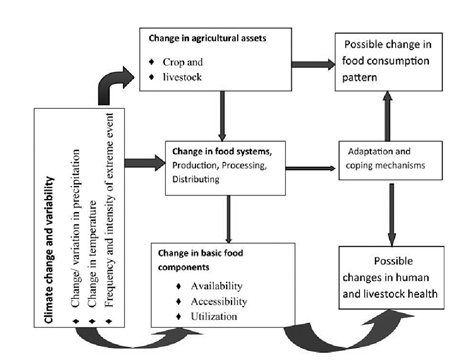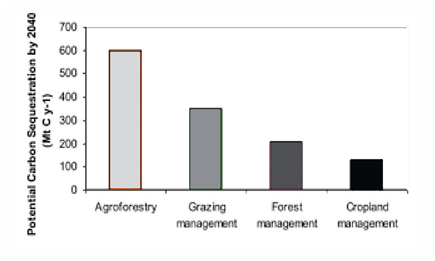Introduction
Climate unpredictability is a reality that presents difficulties for everyone. In some places, it is viewed as a change in weather patterns, while in others; it becomes a matter of survival1. This is particularly true in developing nations where the bulk of people rely on agriculture supported by rainfall for a living2. Despite the fact, that many people rely on agriculture for their livelihoods it is the one that is most vulnerable to the effects of climate change (CC)3. Due of this, communities that depend on it may be exposed to climate variability (CV). As that agriculture is rain-fed, one of the main solutions is to take agricultural or land-use measures that could lessen or accommodate the risks associated with CC4.
Due to the substantial effects that CC is having on natural and human systems across all continents, food production is declining and there is an increase in food insecurity in many regions of the world5. Nelson6 estimates that during the next 40 years, agricultural productivity could decrease by 10-20 %, which would have a severe effect on rural populations in developing and transitional nations7. Solutions are being developed to mitigate the expected effects of CC and the poor's vulnerability to it2.
Agroforestry (AF) is frequently suggested as a solution to the problems of both food security and CC8. When there are two or more crop seasons in a row, AF practices like planting leguminous trees during the fallow period are used (improved fallow). AF can boost adaptability to CV, mitigate the consequences of extreme weather events like droughts or heavy rains, and improve wellbeing in many tropical regions by integrating short-and long-term trees with crops (distributed intercropping)9. AF contributes to slowing CC while this is happening by expanding and developing carbon sinks, which are regions where carbon dioxide from the atmosphere is absorbed and stored in things like biomass and soil4.
It is important to consider this from the farmers' perspective because local biophysical and socioeconomic factors greatly determine how much AF practices contribute to enhancing farmers' livelihoods10. Despite the worldwide advantage of regulating climate through carbon sequestration, smallholder farmers need to invest in innovative farming practices as well as bettering their livelihoods and changing their lives11. As a result, mitigation efforts at the level of smallholder farms must directly and concretely support farmers' livelihoods, for as by giving them access to food, fuel, or fodder, with mitigation working as a byproduct of the improved agricultural practice12. According to numerous studies, the only factors that are measured are AF essential role in boosting resilience to climate-related hazards or the amount of carbon storage in smallholder systems13. In light of this, the goal of this study was to examine how AF makes farmers less susceptible to CC.
Development
Vulnerability. Is the measure of a system's susceptibility to or incapacity to handle the harsh environment brought on by CC, particularly its unpredictable nature and past extreme occurrences14. The degree of vulnerability of a system depends on its susceptibility to CV, the type, degree, and pace of climatic dissimilarity to which it is strongly exposed, as well as its capacity for survival. Resilience must be increased while exposure and sensitivity must be reduced in order to reduce a system's susceptibility to dangers associated with the climate15.
Vulnerability is one of the traits of environmental and social processes, it is directly tied to the exposed system's susceptibility, sensitivity, and lack of resilience or capacity for adaptation to both extreme and non-extreme situations in the context of CV. It is described as being condition-specific and working in conjunction a dangerous event to increase risk6,11. Fundamental environmental components change continuity from the standpoint of CC, which in turn creates new danger situations for societies. For example, more severe and frequent occurrences may disseminate risk elements to new areas, showing core susceptibility. In fact, future vulnerability is already present in the current circumstances of the societies that may be exposed to future CV16, as a result, underlying vulnerability factors will be exposed rather than necessarily created as new risks arise in previously unaffected areas17.
Well-being. According to a three-dimensional holistic view, human well-being is "a state of being with others, where human needs are met, where one can act meaningfully to pursue one's goals, and where one enjoys and appreciates a satisfactory quality of life"18. According to this theory, happiness includes relational and subjective well-being in addition to material or financial well-being19. In addition, a number of scholars distinguish between the factors that determine wellbeing and their constituents20. Examples of "determinants" are things that lead to or help make improvements in wellbeing while "constituents" are things like happiness, health, and positive interpersonal relationships20. A few determinants are the accessibility of capital, expertise, and clean water.
Climate variability. Due to CV, numerous regions of the world have experienced and will continue to suffer various effects. The annual variance in the climate above or below a long-term average value is known as CV22, refers to climatic fluctuations that occur over seasons or years, as opposed to everyday circumstances, like when one rainy season is more intense or lengthy than others. The tropics have experienced less change in average surface temperatures and precipitation during the past century than the rest of the world23.
According to Intergovernmental Panel on CC (IPCC), CC projections, the majority of the humid and sub-humid tropics may experience a rise in the frequency of droughts, floods, and extreme rainfall events, which typically indicates more precipitation variability. Developing nations that still heavily rely on rain-fed agriculture and other ecological resources will be particularly negatively impacted by CC3. Moreover, due to human activity, rural regions are now more vulnerable to drought24. As population growth in drought-prone areas results in unsustainable land and resource use, drought sensitivity increases.
Impact of climate change on farmers' well-being. Several researches show that adverse impact of CV on farmers' welfare26,27. Rainfall variability can result in either floods or droughts, depending on the kind of deviation from the long-term normal. The management of natural resources, water resources, settlements, infrastructure, and food security are impacted by variations in rainfall28. Farmers that depend on seasonal cues to plant their crops struggle because of the more unpredictable weather patterns26. Planting delays brought on by a decrease in rainfall have a big impact on agricultural output. Some crops are badly destroyed when rain hits early than planned. Farmers sometimes blame unpredictable rainfall that falls late in the growing season for crop illnesses like blight, which lowers their anticipated seasonal income26.
Droughts have serious negative effects on the economy and society, especially in developing nations where a considerable amount of the national Gross Domestic Product (GDP) is derived from agricultural production. Three different types of consequences were discovered, including animal loss, decreased productivity, and higher production costs29. People's wellbeing is directly impacted by these losses, especially in rural communities where livestock is the main source of income. In addition, the demand for natural resources, particularly forests, rises during droughts as a result of increased charcoal production, agricultural development, logging, and forest grazing during dry seasons23.
Floods are more frequent than droughts and changes in rainfall, and they have an immediate negative impact on people's quality of life28. Floods affect communities both instantly and subsequently. Loss of livestock and human life, increased disease risk, movement restrictions, higher commodity prices, contaminated water, trouble accessing cooking supplies, property destruction, and increased food insecurity are some of the immediate effects. Many lasting consequences of floods include decreased soil health, loss of infrastructure and houses, emigration, and lower value of agricultural land. Throughout the past century, damage associated with floods has also grown because to increased land use, loss of forest covers human encroachment on floodplains, and higher population concentrations in flood-prone areas30.
Agroforestry systems. AF is the deliberate integration of woody vegetation (trees or shrubs) with agricultural and/or animal production systems in order to profit from the resulting ecological and economic interactions31. The Common Agricultural Policy (CAP) and other state programs have frequently sped up the transition to specialized forms of agriculture and forestry32. The need to balance productivity and environmental improvement may present a chance for an AF renaissance. When tree and crop systems are integrated, resources (such solar radiation or water) are captured more effectively than when they are separated, as is sometimes the case with AF33. Also, it has been discovered that AF can help with regulating ecosystem services, such as nitrogen cycling.
Agroforestry and vulnerability. Has been suggested as a workable strategy to help subsistence farmers lessen their vulnerability to CC4. Because 15 % of farms there have at least 30 % forest cover, Sub-Saharan Africa has a huge potential to absorb carbon and lower other agriculture-related greenhouse gases (GHG) emissions34. Crop diversification, long rotation techniques for soil conservation, home gardens, bordering plantings, perennial crops, hedgerow intercropping, living fences, enhanced fallows, or mixed stratum AF are some examples of AF systems. With the control of water flow processes and microclimate buffering, well-managed AF can significantly contribute to improving tolerance to confusing climatic fluctuation34.
Due to their deep root systems, trees are thought to be less vulnerable to climate-related dangers like floods and droughts35,36. The qualities of the human-environment system, which consists of the human, social, physical, and natural capital, are what determine a system's sensitivity. AF contributes to the preservation and upkeep of natural resources by, for instance, reducing sources of pollution like dust, minimizing soil erosion, and establishing habitats for wildlife. It expedites adaptable responses to quick changes in ecological circumstances by simultaneously conserving or replenishing soil and water resources34.
A key step in replacing energy sources and addressing the carbon balance issue is the development of sustainable AF methods34. The time and effort needed to obtain fuel wood is significantly reduced by the use of AF9. AF raises a family's total standard of living through increasing agricultural output, off-farm income, wealth, and the farm's environmental conditions. Another material resource employed on the farm for protection and to raise the value of the property is trees37.
Agroforestry's results directly increase resilience. Results like the realization of rights or an increase in wellbeing are important indicators of resilience38. Examining factors including food security, asset ownership, school attendance, nutrition, and other factors might help determine these results. The best asset insurance and plan for dealing with probable CC events is the presence of trees on the farm. AF is a direct source of food and fruit. Also, it offers a further source of income from the selling of lumber and firewood37.
Agroforestry's role in reducing climate vulnerability. Enhancing the wellbeing of farmers due of its dual function in helping farmers adjust to these changes and combating CC through carbon sequestration, AF practices have recently attracted increased attention4. A possible method for assisting subsistence farmers reduce their vulnerability to CC is AF3,4,39. In agricultural systems, trees are employed consciously to boost farm output, diversify income streams, and provide environmental services40.
One strategy to boost farm productivity is to intercrop nitrogen-fixing trees between rows of food crops. This method does this by providing crops with nutrient availability in limited amounts. In AF activities, tree products including fruit, wood, and fuel wood are also used and sold. Due to their deep root systems, trees are thought to be less vulnerable to climate-related shocks like floods and droughts23. Almost half of the demand for both residential and commercial wood is satisfied by AF. For example, they provide about 80 % of the necessary firewood, 70 % to 80 % of the necessary wood for plywood, 60 % of the necessary raw materials for paper pulp, and 9-11 % of the necessary green cattle feed34.
Carbon sequestration potentials of agroforestry. Carbon is removed from the atmosphere via biological or physical processes and stored in a variety of carbon sinks such as vegetation, soils, and seas33. The biomass of above-and below-ground plants, as well as the relatively stable forms of organic and inorganic carbon in the soil profile, all contribute to the terrestrial ecosystem's ability to sequester carbon41. AF techniques could boost soil carbon reserves on arable areas, assisting farmers in implementing CC mitigation strategies and enhancing soil health4,42,43. According to the Kyoto Protocol, AF is an important future approach for reducing atmospheric CO2. In order to raise soil and above-ground carbon stocks globally and lessen greenhouse gas emissions and the effects of CC, AF systems seem to be a potential agricultural management method the flow and long-term carbon storage in the terrestrial biosphere will be significantly impacted by a major expansion in the area covered by AF44. Because they consist of more than two species, like pasture, AF systems are far better at storing carbon than monoculture agricultural fields4.
Improve farmer livelihood. When evaluating the benefits of AF to farmers' lives, which are influenced by local biophysical and socioeconomic factors, it is important to reflect their viewpoints10. The possibility of carbon sequestration to influence climate on a global scale is not a strong justification for farmers to use new farming practices11. As a result, smallholder farm mitigation operations are essential to generate direct benefits to farmers' livelihoods, such as providing food, fuel, or fodder, with mitigation being a co-benefit of higher agricultural output12. The ability of farmers to adjust their way of life to the effects of CC may be improved by AF. Trees play a significant role in preventing CC in addition to limiting exposure to threats associated to the climate45.
Trees on farms significantly improve farmers' capacity to respond to the risks of CC through crop and income diversification, soil and water conservation, and efficient nutrient cycling46. By satisfying the requirements of millions of subsistence farmers for food, fuel, and revenue, AF products can significantly contribute to their economic growth as long as they are supported by effective cultivation, processing, and marketing practices.
Production diversification. AF generally boosts and diversifies agricultural productivity per area of trees, crops, and livestock, protects against negative impact of wind or water flow, and creates new products that increase the farming operation's financial flexibility and diversity47. Also, it can significantly minimize the effects of CC4 AF systems, a conventional resource management adaptation, may present prospects for enhancing farmer adaptation to CC due to their direct provision of food, fodder, and firewood as well as minimizing the effects of CC47. The ability to diversify production, strengthen the resilience of subsistence farmers, and reduce production risk may be achievable as a result of the favorable correlations between AF and adaptation to CC.
Ecosystem protection. Sustainable AF techniques have the potential to protect ecosystems and human livelihoods while providing the groundwork for long-term economic and social development48. In particular, under the current CC scenarios, AF systems support food security for farmers by supplying ecosystem services and diversifying agricultural yield4,49. Planting trees next to crops enhances soil fertility, prevents and controls erosion, reduces water logging, prevents the acidification and eutrophication of streams and rivers, increases local biodiversity, lessens the need for fuel from natural forests, and provides livestock with fodder, according to4. Also, it might strengthen the system's defenses against CC unfavorable effects.
Addressing food security. AF may be advantageous to farmers in a number of ways. By generating more commodities for sale or domestic consumption, it can frequently increase soil fertility and farm household resilience50. The most crucial technologies for guaranteeing food security are AF ones since they assist many people in escaping poverty and combating falling resource and agricultural production. For instance, the yields of crops on more degraded fields can be doubled or tripled when fertilizer trees are mixed with inorganic fertilizers. Furthermore, fodder trees can be utilized in smallholder zero-grazing systems to augment or replace commercial feeds, enhance kinds of temperate and tropical fruits that can be consumed to increase household income and nutrition, and grow swiftly into fast-growing timber and fuel51.
Conclusion
AF has the potential to significantly improve food security, CC resilience, and environmental resource conservation. As a result, households are significantly less likely to be shocked. AF is one of the best approaches to help children overcome their fear of danger and overcome food insecurity. AF is one of the most promising parts, particularly as it relates to rural, smallholder farmers who must adapt to more demanding climatological conditions such as longer droughts, more severe floods, and rainfall that more variable. It has been proposed as a feasible technique for reducing climate sensitivity while also generating resources and income from carbon, wood energy, enhanced soil fertility, improved local climate conditions, and ecosystem services.
A versatile, environmentally beneficial resource management strategy involves trees on farms. Farm trees are utilized to regulate, preserve, and produce. A landscape approach promotes collaboration between mitigation and adaptation, with carbon sequestration serving as a crucial technique for reducing CC. AF is one of the most promising elements, especially for rural, smallholder farmers who must adjust to more difficult climatological conditions such as longer droughts, more severe floods, and more erratic rainfall. It has been presented as a viable method for reducing climate sensitivity while also producing resources and income from carbon, wood energy, improved soil fertility, improved local climate conditions, and ecosystem services.












 uBio
uBio 





